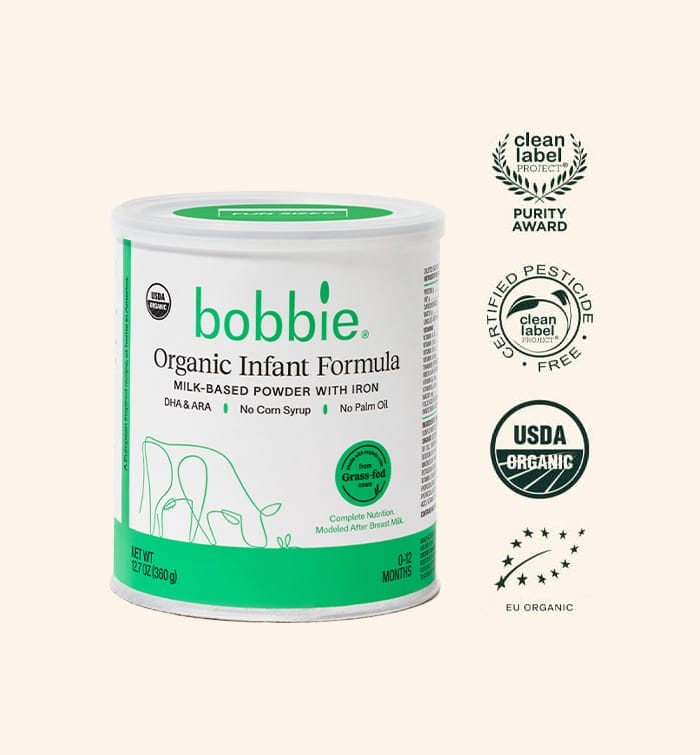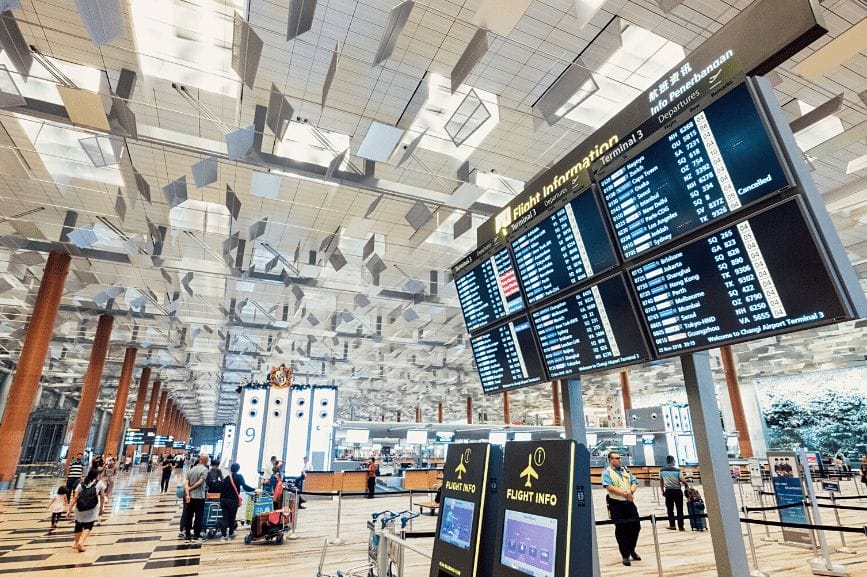We are proud to say that these posts are not sponsored. Our editorial team of Bobbie moms and writers personally select each featured product. If you buy something through our links, we may earn an affiliate commission, at no cost to you.
Avoid the dreaded security line milk dump with these tips from a travel pro and mother of two.
Flying with babies is stressful, even if they miraculously spend most of the flight sleeping. Luckily, one thing you don’t need to worry about when it comes to air travel is whether you can bring enough baby formula or breast milk to keep your baby happy and well-fed throughout your trip.
While passengers are usually allowed to bring a maximum of 3.4 ounces [100 mls] of liquid in their cabin luggage, that rule doesn’t apply to milk and food for infants and young children. Breast milk and formula are considered medically necessary liquids. This also applies to breast milk pumping equipment. You do not need to travel with your child to bring breast milk.
The Formula Mom’s expert tips on traveling with baby formula
We spoke to Mallory Whitmore, aka The Formula Mom. Her biggest piece of advice? You can chat with TSA via iMessage ahead of your trip to ask questions. The benefit is that you have a record of their response if you need to reference it with them during travel! To reach them, visit TSA customer service online. Under “Ask TSA” select “Apple Messages”— it opens a text thread! For android users there’s the option to use FB messenger.
How much baby food can I take on a plane?
Experienced travelers know that snacks, and lots of them, are key to keeping kids relaxed mid-flight. Extra feeds can be a great source of comfort for babies in unfamiliar surroundings, too. That’s why we suggest packing twice as much milk as you think your baby will need, even if you’re taking a very quick plane trip.
Doubling up when flying with breast milk will reduce the stress of any unexpected delays, annoying spills, long lines, or lost luggage upon your arrival. It’s always better to be prepared.
Formula, breast milk, juice, and baby foods in quantities greater than 3.4 ounces [100mls] are allowed in carry-on baggage and don’t need to fit in a quart-sized bag.
According to Transport Security Administration [TSA] guidelines, you’re permitted to bring larger amounts of breast milk and baby formula in reasonable quantities for your trip.
Security screening officers have the final say on what’s considered “a reasonable quantity,” but they’re unlikely to bat an eyelid at an entire carry-on bag full of baby food. This can include items like:
- Your baby’s milk of choice
- Sterilized water
- Juice
- Food in liquid, gel, powder or paste form (like yogurts and purees).
Bobbie mom, Angela, shares her tips for traveling with baby formula: Bring formula water in your thermos and make sure it’s in your diaper bag! The key is to keep everything in your diaper bag so it’s very clear for the TSA that it’s for your baby.

Shop Bobbie Organic Infant Formula
Bobbie Organic Infant Formula is a USDA Organic, EU-style infant formula that meets all FDA requirements. It is a complete nutrition milk-based powder modeled after breast milk and is easy on tummies. It is non-GMO and doesn't have corn syrup, palm oil, or maltodextrin. Learn more about Bobbie.
Quick Summary
- TSA guidelines allow flying with breastmilk and baby formula in reasonable quantities.
- You can double the amount your baby will typically consume during travel, and this will likely still fit into the screening officers’ “reasonable quantity” guideline.
Inspections, what to expect with baby formula
Everyone wants to get through airport security as fast as possible. So how can you avoid any hurdles with your milk stash?
Declare your baby’s milk and foods to security officers at the beginning of the checkpoint for inspection. Then, remove them from your carry-on bag to be screened separately from the rest of your stuff.
You don’t need to be traveling with your baby when transporting breast milk. You may be asked to open any milk bottles for further inspection as liquids are typically screened by X-ray. If it’s feasible, you could also be asked to transfer a small quantity of milk to another container or dispose of a small amount.
The Food and Drug Administration (FDA) states that there are no known adverse effects from eating food, drinking beverages and using medicine screened by X-ray.
Quick Summary
- You will need to remove formula, breast milk and juice from your carry-on bag to be screened separately.
- Food, beverages and medicines screened by X-ray are safe to consume.
- You don’t need to be traveling with your baby to carry formula or breast milk on a plane.
Don’t be afraid to advocate
If you’re not comfortable having your baby’s formula, breast milk or baby food X-rayed or opened, you’re well within your rights to decline.
The TSA formula rules state that additional screening steps can be taken to clear your liquids, such as a pat-down and further screening of your other carry-on luggage. If your breast milk is frozen, a visual inspection is usually sufficient.
Once on board, most cabin crew won’t mind warming up your baby’s milk or food during your flight. In our experience, it’s often too hot when you get it back, so try to plan for extra time to cool it back down to a suitable temperature and give it a quick rub with an anti-bacterial wipe before feeding it to your baby.
Ice packs, freezer packs, frozen gel packs and other accessories used to cool formula, breast milk and juice are allowed in your carry-on but may be subject to additional screening if slushy or partially frozen. You can also bring gel or liquid-filled teethers.
Quick summary when it comes to traveling with baby formula
- You can decline to have your baby’s food X-rayed or opened for inspection, but you may have to undergo additional screening.
- If you have the cabin crew warm your baby’s meal, check the temperature and sanitize the bottle before giving it to your baby.
- Accessories used to cool your baby’s food are allowed in your carry-on but may be subject to additional screening if they’re not fully frozen.
Rules vary based on your destination
Rules can vary from country to country, so be sure to research what’s permitted at your specific travel destination. Airport websites are usually a great place to find everything you need to know about what you can and can’t bring for your baby.
For additional tips on feeding your baby while on the go, the following blog posts are a great source of information:
Formula feeding and breastfeeding— Can you do both?
Can you use tap water for baby formula?
Does baby formula need to be warm?

Shop Bobbie Organic Infant Formula
Bobbie Organic Infant Formula is a USDA Organic, EU-style infant formula that meets all FDA requirements. It is a complete nutrition milk-based powder modeled after breast milk and is easy on tummies. It is non-GMO and doesn't have corn syrup, palm oil, or maltodextrin. Learn more about Bobbie.

